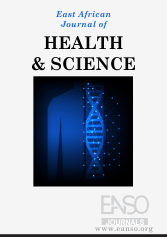The Role of Nutrition Therapy in Recovery from Severe Burns: A Case Report from Muhimbili National Hospital, Mloganzila
Abstract
Background: Severe burn injuries are associated with profound hypermetabolic and catabolic responses that significantly increase nutritional requirements. Effective nutritional management is crucial for promoting wound healing, minimising complications, and improving recovery outcomes, especially in resource-limited settings. Purpose: This case report aims to highlight the practical and individualised nutritional strategies used to manage a patient with extensive burn injuries in a low-resource ICU setting. Methods: A 30-year-old male was admitted to Muhimbili National Hospital–Mloganzila following a motor traffic accident, sustaining deep second-degree burns over 53% of his total body surface area (TBSA), including the trunk, back, forearms, lower limbs, and buttocks. Upon admission, he presented with fluid imbalance, hypoalbuminemia, and functional feeding limitations. Nutritional needs were calculated using the Curreri formula, and a tailored nutrition care plan was developed. Fluid resuscitation followed the Parkland formula. Meals were provided from both hospital and home sources, supplemented with high-protein oral feeds, zinc (15 mg), and vitamin C (500 mg). Caregiver involvement and nursing support were integrated into the feeding process. Key Results: The individualised nutrition plan, supported by interdisciplinary collaboration and caregiver education, contributed to achieving target nutritional intake and clinical improvements. The patient showed gradual recovery with stabilised albumin levels, improved wound healing, and reduced complications. Conclusion: In resource-limited settings, effective burn nutrition therapy is feasible using locally available foods, targeted supplementation, and multidisciplinary coordination. Early assessment, tailored interventions, caregiver engagement, and regular monitoring are critical to successful burn recovery outcomes
Downloads
References
Chourdakis, M., Bouras, E., Shields, B. A., Stoppe, C., Rousseau, A. F., & Heyland, D. K. (2020). Nutritional therapy among burn injured patients in the critical care setting: An international multicenter observational study on “best achievable” practices. Clinical Nutrition, 39(12), 3813–3820. https://doi.org/10.1016/j.clnu.2020.04.023
KeMoH. (2010). Republic of Kenya Ministry of Medical Services Kenya National Clinical Nutrition and Dietetics Reference Manual First Edition. February.
KeMoH. (2020). Republic of Kenya, Kenya clinical nutrition and dietetics manual (second edition), A Reference manual for Nutrition and Dietetics professionals.
Laviano, A., Di Lazzaro, L., & Correia, M. I. T. D. (2017). To feed or not to feed in ICU: Evidence-based medicine versus physiology-based medicine. In Nutrition (Vol. 41, pp. A4–A5). Elsevier Inc. https://doi.org/10.1016/j.nut.2017.02.006
Mutua, D. K., Wamalwa, D., Admani, B., Wanjeri, K., Lina, M., & Nutritionist, N. (2009). Nutritional Status Of Pediatric Burn Patients Hospitalised At Kenyatta National Hospital Using Anthropometric Measurements.
Ojo, O., Adegboye, A. R. A., Ojo, O. O., Wang, X., & Brooke, J. (2020). The microbial quality and safety of blenderised enteral nutrition formula: A systematic review. In International Journal of Environmental Research and Public Health (Vol. 17, Issue 24, pp. 1–12). MDPI AG. https://doi.org/10.3390/ijerph17249563
Rousseau, A. F., Losser, M. R., Ichai, C., & Berger, M. M. (2013). ESPEN endorsed recommendations: Nutritional therapy in major burns. Clinical Nutrition, 32(4), 497–502. https://doi.org/10.1016/j.clnu.2013.02.012
Windle, E. M. (2008). Nutrition support in major burn injury: case analysis of dietetic activity, resource use and cost implications.
Copyright (c) 2025 Arafa E. Mkumbo, Ulumbi Kilimba, Howard Kingu, Petro Lazaro, Ashura Kazema, Wilson Gwessa

This work is licensed under a Creative Commons Attribution 4.0 International License.




























